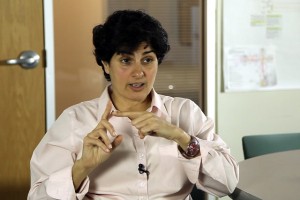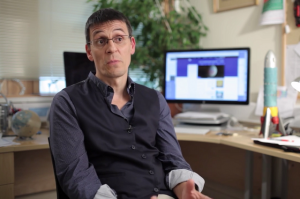The Search for Gravitational Waves
Physicist Nergis Mavalvala on the general theory of relativity, Hulse-Taylor system, and the way gravitational...
What are some paradoxes of black holes? How can Quantum Mechanics help with a better understanding of black holes? How can gravitational waves better explain the structure of spacetime? These and other questions were answered by Harvard Prof. Avi Loeb.
Some of the most fascinating objects in the universe are black holes. These were predicted almost 100 years ago as a result of the general theory of gravity, that was developed by Albert Einstein. These are the end state in the collapse for example of massive stars. These objects are found in the centres of galaxies, where a lot of gas is assembled and collapses to the centre. We would like to understand better, what is going on in the vicinity of black holes. There are some unresolved questions that have to do with how quantum mechanics is unified with gravity. They produce paradoxes in the vicinity of a black hole. Because a black hole is the ultimate prison. You can check into it but you can never check out of it. Even light cannot escape from black holes. Except that when you include quantum mechanics, there is some probability of escape from a black hole. And that produces some paradoxes in attempts to unify quantum mechanics and gravity. In astrophysics, we find a lot of black holes. The most massive ones are found in the centres of galaxies. And in fact our galaxy has a black hole at its centre. It has a mass that is 4 million times the mass of the sun. It’s the biggest black hole in the sky meaning that it has the largest angular size on the sky. If we wanted for example to get an image of the shadow of a black hole, the black hole in the centre of our galaxy should be the first target, because it would be the biggest on the sky and we could resolve it to the best of our ability.
We currently have the technology to in principle image that shadow in the centre of our galaxy.
The way to do that is using radiation that has a wavelength of roughly 1mm. Turns out that if you’ll use the entire Earth as a one big giant telescope then at a wavelength of 1mm you get the resolution to be able to resolve the size of the horizon of the black hole at the centre of our galaxy. How can we build a telescope as big as the Earth? Well, we can do that by placing observatories at millimetre wavelength throughout the globe. In fact, we have already some millimetre observatories spread around the Earth. The only thing we need to do is correlate the signal that we receive at these observatories to get an image or to constrain the image of the shadow of the black hole at the centre of our galaxy. This work is ongoing and in principle within the coming decade, we should be able to get an image of the shadow of the black hole at the centre of the Milky Way. There is another galaxy, giant galaxy, called M 87 that has a much bigger black hole. Few thousand times bigger in mass than the one at the centre of the Milky Way. But it’s also a few thousand times farther away. So on the sky it has roughly the size of the black hole at the centre of the Milky Way. So that’s another system, where we can in principle image the black hole. The main difference is that M 87 has a jet. So we can actually learn about how jets are being produced in the vicinity of accreting black holes — black holes into which gas is flowing.
Next to our galaxy there is the Andromeda galaxy, our sister galaxy, which is very similar to the Milky Way, and it’s approaching us, it’s on a collision course with the Milky Way. Within a few billion years Andromeda will collide with the Milky Way, and the two galaxies will mix together and become one big galaxy, an elliptical galaxy. The two black holes, the one at the centre of the Andromeda galaxy and the one at the centre of the Milky Way, will make a binary black hole system. And eventually these two black holes will come together and coalesce to make a single black hole. This process of making black hole binaries that eventually coalesce and make a single black hole happened many times in the history of the universe. When two black holes come together, they produce ripples of space-time. Just like when you through a stone on a surface of a pond you generate waves that propagate out; the same way when you have two black holes orbiting around each other, they produce ripples in space-time. These are called gravitational waves and the gravitational waves are emitted. And in principle, there are plans to detect those gravitational waves emitted from black holes binaries at great distances. That would be a fantastic way of learning about the structure of space-time around a black hole by monitoring the ripples in space-time that propagate across cosmological distances to us.

Physicist Nergis Mavalvala on the general theory of relativity, Hulse-Taylor system, and the way gravitational...

Physicist Lyman Page on thermal radiation, quadrupolar distribution, and the early Universe

Astrophysicist Didier Queloz on the how to find exoplanets, their impact on astronomy, and the uniqueness of o...